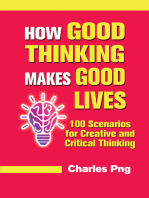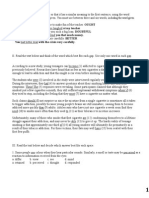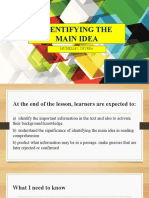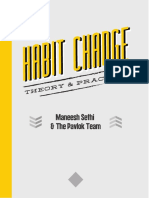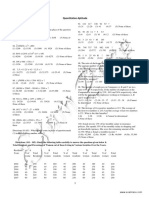50%(2)50% found this document useful (2 votes)
408 viewsLab Questions Dropbox PDF
Jack invented a new pancreatic cancer diagnostic test that is faster, cheaper, and more sensitive than current tests after his uncle died from pancreatic cancer that doctors could not diagnose in time. When participating in an Extreme by Design project, the most important lesson teams learned was developing empathy to understand problems from different perspectives. The teams used empathy through observation and collecting stories to understand the problems locals faced. They were asked to develop a cheap CPAP machine for children in 3rd world countries who cannot afford the expensive machines.
Uploaded by
Pedro Alvarez SabinCopyright
© © All Rights Reserved
Available Formats
Download as PDF, TXT or read online on Scribd
50%(2)50% found this document useful (2 votes)
408 viewsLab Questions Dropbox PDF
Jack invented a new pancreatic cancer diagnostic test that is faster, cheaper, and more sensitive than current tests after his uncle died from pancreatic cancer that doctors could not diagnose in time. When participating in an Extreme by Design project, the most important lesson teams learned was developing empathy to understand problems from different perspectives. The teams used empathy through observation and collecting stories to understand the problems locals faced. They were asked to develop a cheap CPAP machine for children in 3rd world countries who cannot afford the expensive machines.
Uploaded by
Pedro Alvarez SabinCopyright
© © All Rights Reserved
Available Formats
Download as PDF, TXT or read online on Scribd
You are on page 1/ 2
Lab Questions Dropbox
1. What did 15-year-old Jack invent? Why?
Jack created a new diagnostic test for pancreatic cancer which is 28 times
faster, 26,000 times less expensive and over 100 times more sensitive than
the current diagnostic test and it also works for ovarian and lung cancer. He
invented this diagnosis test after his uncle’s death because of pancreatic
cancer. (Doctors couldn’t diagnose the disease at time)
2. What was the most important lesson the teams learned
when participating in the Extreme by Design projects?
The most important lessons the teams learned were to develop empathy with
others to understand better the problem and see it from a different
perspective.
3. What tools did the teams use to learn about the problems they were
to solve?
They used empathy (based in observation and collection of stories) to
understand better the problems which locals had to face.
4. What problem that the team asked to solve in this episode?
Why?
They were asked to develop a cheap CPAP (Continious Positive Airway
Pressure) machine for children who live in 3rd world countries because
the most of people and organizations in this countries can’t afford this
machines.
5. Use the five minutes given in the video to write about what
you observed as one of the team members, Chris, tried work
out a problem.
From my point of view, I found Chris a willing and persevering person
who works until he achieves his goals by looking for different
alternatives. However, he gets frustrated relatively quickly and falls apart
easily, making it very difficult for him to organize his ideas and be more
efficient.
6. Think of a time when you heard a story from someone who
was unhappy and didn't know what to do. Describe the story.
How do you think the person felt in this situation?
About 3 years ago, I heard the story of a 60-year-old woman who
suffered a brain tumor and when she woke up she didn't know if she
would be able to walk again or if she would have to stay in a wheelchair
for the rest of her life. They had to perform painful tests on her and
before knowing the results she was very anxious and not knowing what
to do in case the hypothetical situation arose that she would stay in a
wheelchair. It was a very difficult time for her. I think in that situation, she
must have felt frustrated and very lonely because she had no family to
support her at the time. I also think that I should feel fear and uncertainty
when I don't know what would happen.
1. What problem was the team presented with in this episode?
What problem might they have thought they should solve if
they hadn't listened carefully?
The problem they found was an error in the storage of water in the wells
that caused the inhabitants to run out of water during times of drought. If
the group had not listened carefully they would probably have thought
that the problem was in the process of collecting the water.
2. Consider the problem of the migrant worker with traditional
mosquito nets. What is the problem statement you came up
with?
The main problem that comes to mind is that the anti-mosquito net
cannot be used while workers are working so they need an alternative to
be able to protect themselves from this disease.
3. Think of as many innovative solutions as you can for the
migrant worker.
Anti mosquito cream/spray
Long-sleeved clothing that insulates the body from bites
Radiation emitters that kill mosquitoes
4. What have you learned about designing solutions? How does
this apply to engineering? Think of some engineering solutions
that started with a simple problem, and write them down.
I have learned that it is essential to try to innovate in the simplest way
possible by modifying inventions that already exist today or by devising
mechanisms to solve a specific problem like it is done in nowadays
engineering.
Problem. Solution.
Difficulty to orientate. Compass
Limitated transmission of knowledge Printing press
Covering long distances Car
You might also like
- Hourglass Workout Program by Luisagiuliet 276% (21)Hourglass Workout Program by Luisagiuliet 251 pages
- The Hold Me Tight Workbook - Dr. Sue Johnson100% (16)The Hold Me Tight Workbook - Dr. Sue Johnson187 pages
- Read People Like A Book by Patrick King-Edited62% (66)Read People Like A Book by Patrick King-Edited12 pages
- Livingood, Blake - Livingood Daily Your 21-Day Guide To Experience Real Health77% (13)Livingood, Blake - Livingood Daily Your 21-Day Guide To Experience Real Health260 pages
- COSMIC CONSCIOUSNESS OF HUMANITY - PROBLEMS OF NEW COSMOGONY (V.P.Kaznacheev,. Л. V. Trofimov.)94% (212)COSMIC CONSCIOUSNESS OF HUMANITY - PROBLEMS OF NEW COSMOGONY (V.P.Kaznacheev,. Л. V. Trofimov.)212 pages
- Donald Trump & Jeffrey Epstein Rape Lawsuit and Affidavits83% (1016)Donald Trump & Jeffrey Epstein Rape Lawsuit and Affidavits13 pages
- The 36 Questions That Lead To Love - The New York Times94% (34)The 36 Questions That Lead To Love - The New York Times3 pages
- The 36 Questions That Lead To Love - The New York Times95% (21)The 36 Questions That Lead To Love - The New York Times3 pages
- Jeffrey Epstein39s Little Black Book Unredacted PDF75% (12)Jeffrey Epstein39s Little Black Book Unredacted PDF95 pages
- The 4 Hour Workweek, Expanded and Updated by Timothy Ferriss - Excerpt23% (954)The 4 Hour Workweek, Expanded and Updated by Timothy Ferriss - Excerpt38 pages
- Assignment 19 - Written Assignment - The Great Depression PDFNo ratings yetAssignment 19 - Written Assignment - The Great Depression PDF1 page
- Service Manuals LG TV LCD 42LG61YD 42LG61YD Service ManualNo ratings yetService Manuals LG TV LCD 42LG61YD 42LG61YD Service Manual45 pages
- Creativity Report - Group 16-Animesh ShuklaNo ratings yetCreativity Report - Group 16-Animesh Shukla10 pages
- How Good Thinking Makes Good Lives: 100 Scenarios for Creative and Critical ThinkingFrom EverandHow Good Thinking Makes Good Lives: 100 Scenarios for Creative and Critical ThinkingNo ratings yet
- Answer Key of Level 4A Unit 1 , 2 and 3No ratings yetAnswer Key of Level 4A Unit 1 , 2 and 317 pages
- Writing final quiz (Recuperado automáticamente)No ratings yetWriting final quiz (Recuperado automáticamente)2 pages
- Worksheet: What do you mean by "impact"? – yourNameNo ratings yetWorksheet: What do you mean by "impact"? – yourName10 pages
- 01 Practical Research 1 - Importance of Research in Daily LivesNo ratings yet01 Practical Research 1 - Importance of Research in Daily Lives3 pages
- CO 2024 LS Grade12 CUF RESEARCH1 WEEK1 HNo ratings yetCO 2024 LS Grade12 CUF RESEARCH1 WEEK1 H9 pages
- Argumentation Cloning Ursula Adams StudentNo ratings yetArgumentation Cloning Ursula Adams Student17 pages
- Orthopaedic Pillow: Theory and Practice Shuori Yamada instant downloadNo ratings yetOrthopaedic Pillow: Theory and Practice Shuori Yamada instant download49 pages
- MODULE I Definitivo - Optativa Enfermería 2019No ratings yetMODULE I Definitivo - Optativa Enfermería 201918 pages
- UNIT 5 2ND TERM B BOOKLET 2024-2025 (1)No ratings yetUNIT 5 2ND TERM B BOOKLET 2024-2025 (1)22 pages
- IEC hygiene in schools DC - Latrines 08.11.11-logosNo ratings yetIEC hygiene in schools DC - Latrines 08.11.11-logos16 pages
- Health8 - q3 - Mod5 - Misconceptions, Myths, and Beliefs About Common Communicable DiseasesNo ratings yetHealth8 - q3 - Mod5 - Misconceptions, Myths, and Beliefs About Common Communicable Diseases14 pages
- Assignment 21 Creative Assignment Attack On Pearl Harbor PDFNo ratings yetAssignment 21 Creative Assignment Attack On Pearl Harbor PDF7 pages
- Warsash New Training Requirements Under Stcw10No ratings yetWarsash New Training Requirements Under Stcw106 pages
- Present Simple or Present Continuous 2018No ratings yetPresent Simple or Present Continuous 20181 page
- WWW - Yoquieroaprobar.es: Elementary Test - 1100% (1)WWW - Yoquieroaprobar.es: Elementary Test - 130 pages
- How To Import WBS From Excel To Primavera P6 Using The P6 SDKNo ratings yetHow To Import WBS From Excel To Primavera P6 Using The P6 SDK17 pages
- Help Children Be Grateful Pray-Ers: NovemberNo ratings yetHelp Children Be Grateful Pray-Ers: November4 pages
- Techniques For The Seismic Rehabilitation of Existing BuildingsNo ratings yetTechniques For The Seismic Rehabilitation of Existing Buildings167 pages
- Welcome To Timisoara, Romania: How To Get Here?No ratings yetWelcome To Timisoara, Romania: How To Get Here?10 pages
- Quantitative Aptitude Sample Paper 1 PDFNo ratings yetQuantitative Aptitude Sample Paper 1 PDF9 pages











































